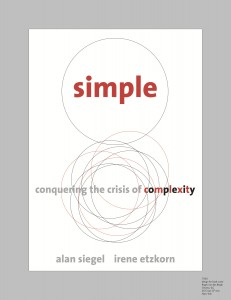For decades, Irene Etzkorn and Alan Siegel have championed simplicity as a competitive advantage and a consumer right. Consulting with businesses and organizations around the world to streamline products, services, processes, and communications, they have achieved dramatic results. Simple is a groundbreaking and invaluable guide to achieving the three fundamental principles of simplicity: clarity, transparency, and empathy. It lays the foundation for organizations that want to enhance the customer experience as a way to drive business results.
Irene, my guest next week on the Business901 podcast, is a worldwide authority on simplicity, built the Simplification practice of Siegel+Gale. As executive director of Simplification, her clients include the nation’s top banks, brokerage firms, insurance companies, utilities, and health care providers.
I enjoyed the book, Simple: Conquering the Crisis of Complexity, and the podcast. Below is a brief excerpt from the upcoming podcast.
Joe: What are the secrets to simplification? Is there something that when you walk in that guides you towards complexity? Is there a secret to understanding how to look at things with simple eyes?
Irene: Yes, there is and I think it lies in the fact that clarity is best achieved through an intuitive structure of information. Most often, we find people who have a complicated topic or complicated communication want to begin by re-writing and/or re-designing. Those are two ingredients and important skills and certainly ones that we advocate. They are not the place to begin. It is necessary to begin and look at the process. What is the data, the content? What do you know about this customer? For example, if you already know what state they live in, you don’t have to include a lot of “if-then” clauses that say “if you’re in Michigan”, “if you are in New York”, etcetera and have the person deal with all that. Instead, you can push out to them a customized communication. Starting further up the chain and providing a summary to a more detailed approach. Can you answer likely questions for 80% or 90% of the readers or the users upfront? People who have further questions can continue on in the communication, but you haven’t created an introductory barrier for the majority of people. In actions, a lot of simplification is about intuitive organization and structure.
Another example of that is insurance policy. Property casualty insurance, people do not read their insurance policy, for some, they are novel. They read them usually at the time of need when they have a claim. Putting what to do if you have a claim as the first item in a policy is much more customer focused. That is a reflection of the organization of the company that’s producing it. It is a more meaningful document for the consumer.
Joe: I think you made the great example there because it’s amazing how many times the redundancy is built in and I think of health care right away where I am asked the same question so many times that I feel that I probably had to have answered it wrong along the way.
Irene: Absolutely and that’s a good example because one of the 3 key principles that we’ve talked about in the book to achieve simplicity, one of them is empathy and emphasizing with the circumstance of the communication or the interaction is really important. When you mention health care, that’s a great example, not only are you sometimes being asked for the same information repeatedly, you may be in a state where half the time you are drugged or you’re ill. Obviously, for some reason, you’re seeking health care. It’s not your finest moment probably in terms of clarity of thought and emotional state etcetera etcetera. It’s a good example where even more so in that circumstance, you would want things to be accessible, clear and not redundant certainly.
Joe: You mentioned empathy, what are the other 2 key principles?
Tune in next week to the podcast for the answer or if you cannot wait buy the book,Simple: Conquering the Crisis of Complexity.
About Siegel+Gale: (www.siegelgale.com) Simplicity is the centerpiece of the strategies they develop that reveal the unique truths of an organization, the engaging stories they create that connect brands with their audiences and the meaningful experiences they deliver that are both unexpectedly fresh and remarkably clear. Since 1969, Siegel+Gale has championed simplicity for leading corporations, nonprofits and government organizations worldwide.

Comments are closed.